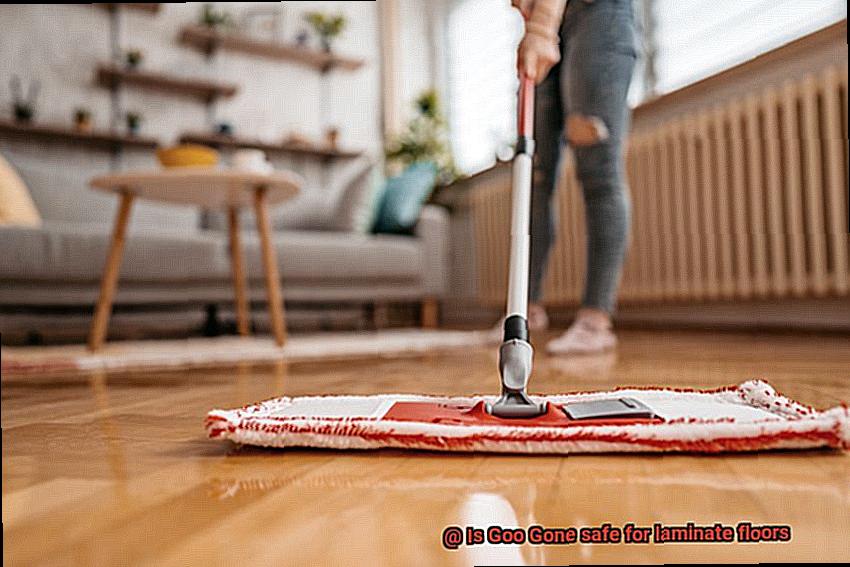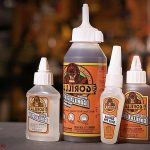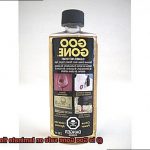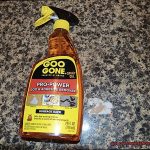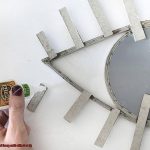Got a sticky mess or stubborn adhesive residue on your gorgeous laminate floors? Wondering if Goo Gone is the hero you need? Laminate flooring is all the rage, with its affordability, durability, and stunning finishes. But when it comes to tackling tough stains or sticky substances, finding the right solution can be a real head-scratcher.
In this blog post, we’re diving into the great debate about whether using Goo Gone on laminate floors is safe. We’ll uncover the truth behind all those claims and address common concerns about potential damage, residue, and how it affects your precious flooring investment. So grab your detective hat as we investigate whether this go-to adhesive remover is a friend or foe to your beloved laminate floors.

Is Goo Gone Safe for Laminate Floors?
Contents
- 1 Is Goo Gone Safe for Laminate Floors?
- 2 How to Test Goo Gone on Laminate Floors
- 3 How to Apply Goo Gone on Laminate Floors
- 4 Cleaning After Applying Goo Gone on Laminate Floors
- 5 Rinsing After Applying Goo Gone on Laminate Floors
- 6 Potential Damage or Discoloration from Using Goo Gone on Laminate Floors
- 7 Contacting the Manufacturer or Professional for Assistance with Damage or Discoloration from Using Goo Gone on Laminate Floors
- 8 Conclusion
Goo Gone, a popular adhesive remover, is often used to tackle sticky residue on a wide range of surfaces. But what about laminate floors? Opinions and experiences are mixed when it comes to using Goo Gone on this type of flooring. So, let’s dive deeper into the facts to determine whether Goo Gone is safe for laminate floors.
Laminate floors are known for their durability and easy maintenance. Composed of layers of synthetic materials topped with a protective layer, they require special care when it comes to cleaning agents.
Goo Gone contains citrus oil as its main ingredient, renowned for its powerful cleaning properties. However, it’s important to note that citrus oil can have a solvent-like effect and potentially damage the protective layer of laminate flooring if used excessively or left on the surface for too long. To avoid any mishaps, apply Goo Gone sparingly and resist the temptation to vigorously scrub the floor.
To ensure compatibility, it is highly recommended to test Goo Gone on a small, inconspicuous area of your laminate floor before applying it to the entire surface. This will help identify any adverse reactions like discoloration or damage. Additionally, read the manufacturer’s instructions carefully and follow them diligently.
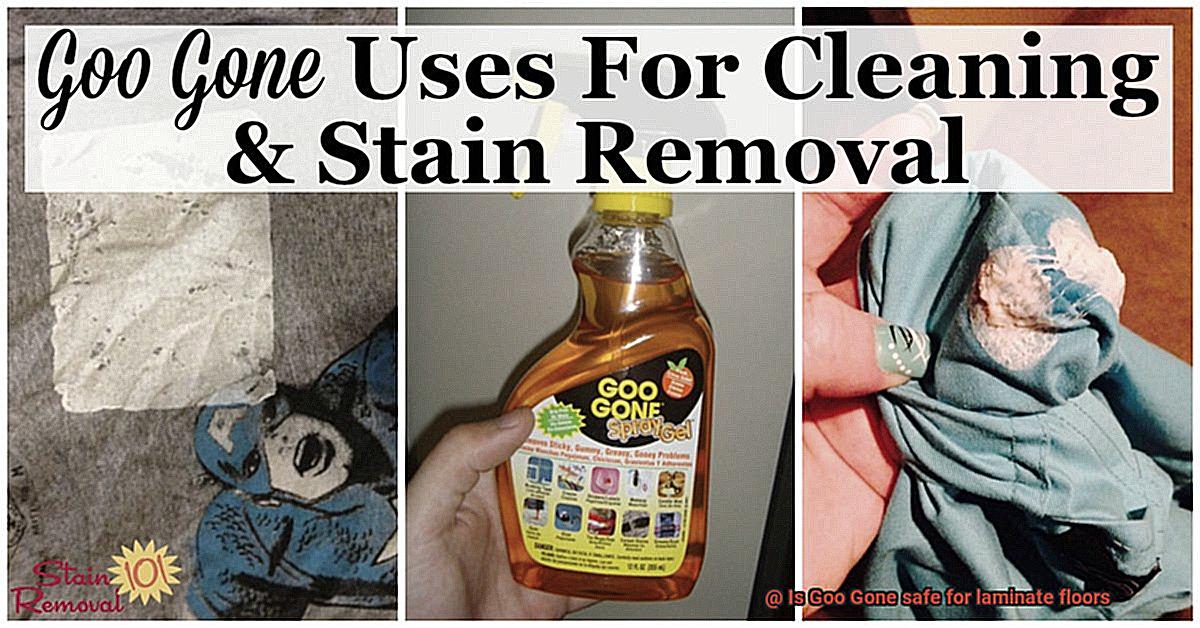
Once you’ve applied Goo Gone, don’t forget the crucial next step: thorough cleaning. Use a mild detergent and water to remove any residue from the floor. This step is essential in preventing any potential buildup that could harm your laminate surface. Rinse the floor with clean water afterward to ensure all traces of Goo Gone are removed.
If you encounter any damage or discoloration after using Goo Gone on your laminate floors, it’s advisable to seek assistance from the manufacturer or consult a professional. Alternatively, there are adhesive removers specifically designed for use on laminate floors that may be a safer choice.
How to Test Goo Gone on Laminate Floors
To properly test Goo Gone on laminate floors, it is essential to follow a systematic process that ensures the product is both safe and effective. Here are the steps you should take:
Choose a small, inconspicuous area
Before applying Goo Gone to the entire laminate floor, select a small spot that is hidden or less visible, such as under furniture or in a corner. This will help minimize any potential damage if the product does not work well with the laminate material.
Prepare the area
Clear the selected spot of any objects or debris that may interfere with the test. Sweep or vacuum the area to remove any loose dirt or dust particles.
Apply Goo Gone
Dampen a clean cloth or sponge with Goo Gone and gently apply it to the chosen area. Be sure to follow the instructions on the product label for proper application techniques.
Let it sit
After applying Goo Gone, allow it to sit on the laminate floor for a few minutes. This will give the product time to penetrate and loosen the sticky residue.
Test for colorfastness
Before proceeding further, it is essential to check if Goo Gone causes any discoloration or damage to the laminate surface. Take another clean cloth or sponge and lightly dab the treated area. If there is no color transfer or noticeable damage, you can proceed with confidence.
Gently agitate
To enhance the effectiveness of Goo Gone, gently agitate the treated area using a soft-bristle brush or cloth. This will help loosen and lift the sticky residue from the laminate surface.
Wipe clean
Using a clean cloth or sponge, wipe away the Goo Gone residue along with the loosened glue. Make sure to remove all traces of the product from the laminate floor.
Inspect and evaluate
After cleaning, inspect the treated area for any remaining residue or damage. If the laminate floor appears to be in good condition and free from residue, it indicates that Goo Gone is safe to use on the rest of the flooring.
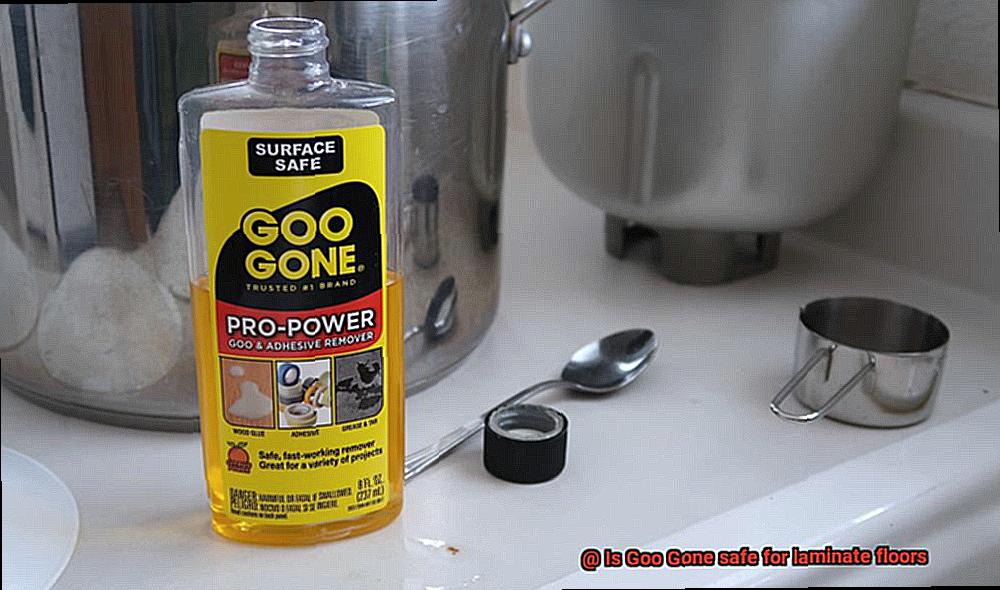
How to Apply Goo Gone on Laminate Floors
Before using Goo Gone on your laminate floor, it’s crucial to test it on a small, inconspicuous area. This ensures that it won’t cause any damage or discoloration. Apply a small amount of Goo Gone on a cloth and gently rub it on the test area. After a few minutes, wipe it off to check for any adverse effects.
Remove loose debris:
Start by sweeping or vacuuming the floor to remove loose dirt or debris. This prevents scratching the surface during the cleaning process.
Apply Goo Gone sparingly:
Pour a small amount of Goo Gone onto a clean, lint-free cloth or sponge. Avoid applying the product directly onto the laminate floor to prevent over-application and potential damage.
Rub gently:
Gently rub the cloth or sponge with Goo Gone over the sticky residue or adhesive on the laminate floor. Use circular motions and apply light pressure to avoid damaging the surface. Thoroughly cover the affected area.
Let it sit:
Allow the Goo Gone to sit on the adhesive for a few minutes to penetrate and loosen it. This makes it easier to remove.
Wipe away residue:
After sufficient dwell time, use a clean cloth or sponge dampened with warm water to wipe away the loosened residue. Rinse the cloth or sponge frequently in clean water to prevent re-depositing adhesive onto the floor.
Rinse with clean water:
Once all residue is removed, rinse the laminate floor with clean water to eliminate any traces of Goo Gone. Thoroughly removing any remaining product is crucial to prevent potential slipping hazards.
Dry gently:
Finally, dry the laminate floor using a clean towel or microfiber cloth. This prevents water spots or streaks from forming on the surface.
Cleaning After Applying Goo Gone on Laminate Floors
Before you start cleaning your laminate floors after applying Goo Gone, it’s important to test the product on a small, inconspicuous area to ensure it doesn’t cause any damage or discoloration. Once you’ve confirmed its safety, follow these steps for a thorough clean:
- Remove debris: Sweep or vacuum the floor to eliminate loose dirt and debris. This prevents the Goo Gone from spreading these particles around and creating a mess.
- Apply Goo Gone sparingly: Apply a small amount of Goo Gone directly onto the sticky or adhesive residue. Avoid using excessive amounts to prevent residue buildup.
- Gently rub: Use a soft cloth or sponge to gently rub the Goo Gone into the sticky residue. Allow it to penetrate and break down the substance for a few minutes.
- Let it sit: Give the Goo Gone about 5-10 minutes to work its magic and loosen the adhesive or sticky substance.
- Wipe away residue: Using a clean, damp cloth or sponge, start from one edge of the floor and work your way across, wiping away the Goo Gone and loosened residue. Be thorough in your cleaning to ensure all residue is removed.
- Rinse with clean water: Dip another clean cloth or sponge into fresh water and wipe down the laminate floor to remove any remaining Goo Gone residue. Rinse and wring out the cloth frequently to prevent spreading residue around.
- Dry gently: Immediately after rinsing, dry the floor with a soft towel or microfiber cloth. This prevents moisture from seeping into the floorboards and causing damage.
- Apply laminate floor cleaner or polish (optional): For added shine and protection, you can apply a laminate floor cleaner or polish specifically designed for this type of flooring. Follow the manufacturer’s instructions for application.
Rinsing After Applying Goo Gone on Laminate Floors
Goo Gone is a powerful adhesive remover that can effectively remove sticky substances from various surfaces, including laminate floors. However, it is crucial to rinse the area thoroughly after applying Goo Gone to ensure no residue is left behind. This is important for several reasons.
Firstly, Goo Gone contains chemicals that can potentially damage laminate surfaces if not properly rinsed off. These chemicals can react with the laminate material and cause discoloration or even deterioration over time. By rinsing the area after using Goo Gone, you can ensure that all traces of the product are removed and prevent any potential damage.
Secondly, residue left behind from Goo Gone can attract dirt and grime, which can create a dull appearance on your laminate floors over time. By thoroughly rinsing the area, you can remove any remaining Goo Gone and restore the natural shine and beauty of your laminate flooring.
To properly rinse after applying Goo Gone on laminate floors, follow these steps:
Gather your materials: a clean, damp cloth or sponge, clean water, and a dry cloth or towel.
Start by using a clean, damp cloth or sponge to wipe away the Goo Gone and any loosened adhesive or residue. Ensure that you wring out the cloth or sponge well to avoid excessive moisture on the laminate surface.
Rinse the cloth or sponge in clean water and repeat the wiping process until all traces of Goo Gone are removed. Remember not to use excessive water or soak the laminate floor, as this can cause damage.
Once the floor has been thoroughly rinsed, use a dry cloth or towel to remove any excess moisture from the surface.
Allow the floor to air dry completely before walking on it.
It is also recommended to test a small, inconspicuous area of the laminate floor before applying Goo Gone to ensure compatibility and avoid any potential damage. If you notice any discoloration or damage during the rinsing process, it is advisable to consult with a professional or contact the manufacturer of the laminate flooring for further guidance.
Potential Damage or Discoloration from Using Goo Gone on Laminate Floors
Goo Gone, a popular adhesive remover, is often used to eradicate sticky residue from various surfaces, including laminate floors. While generally safe for most surfaces, including laminate, improper use can lead to damage or discoloration.
Laminate floors consist of multiple layers—an inner fiberboard core, a decorative layer, and a protective top layer that provides durability and resistance to stains and scratches.
Goo Gone contains potent solvents that dissolve adhesives effectively but can be harsh on some materials, including the protective top layer of laminate flooring.
Failure to promptly wipe off Goo Gone or leaving it on the laminate floor for an extended period can result in seepage into the protective layer, causing unsightly discoloration or damage. Therefore, it is crucial to adhere to the manufacturer’s instructions when using Goo Gone on laminate floors.
Typically, this involves applying a small amount of the product to a clean cloth or sponge and gently rubbing the affected area until the residue is eliminated. To prevent any potential long-term damage, thoroughly rinsing the area with warm water and mild soap is essential.
Before applying Goo Gone extensively, it is prudent to test it on a small inconspicuous area of the laminate floor. This allows for the assessment of any adverse reactions or damage before proceeding. If discoloration or damage occurs after using Goo Gone, it is advisable to discontinue use and consult a professional for alternative methods or products that remove sticky residue without harming the flooring.
Contacting the Manufacturer or Professional for Assistance with Damage or Discoloration from Using Goo Gone on Laminate Floors
When it comes to damage or discoloration caused by using Goo Gone on laminate floors, it is crucial to reach out to the manufacturer or a professional for assistance. Here’s how to go about it:
Firstly, do some research. Understand that using Goo Gone on laminate floors can potentially cause damage or discoloration. Familiarize yourself with the specific risks and effects associated with this product. This knowledge will help you better explain the situation to the manufacturer or professional.
Next, gather all relevant information about the Goo Gone product used and any additional substances present on the floor. This includes the specific formula or variant of Goo Gone, as well as any other cleaning agents or materials that were in contact with the laminate floor. Providing this information will enable the manufacturer or professional to have a clearer understanding of the situation.
Contact the manufacturer of the laminate flooring. They are experts in their product and may have specific instructions or recommendations for dealing with damage or discoloration caused by using Goo Gone. Explain what occurred in detail, including how the Goo Gone was applied and any noticeable changes in the appearance or condition of the floor. It is also helpful to provide clear and accurate photographs to visually illustrate the extent of the damage.
The manufacturer may require additional information or request that a professional inspect the floor in person. This is important for a thorough assessment of the damage and to determine the best course of action for remediation. Follow their instructions and cooperate fully to ensure a satisfactory resolution.
If the damage or discoloration is severe, it is advisable to consult with a professional flooring contractor who specializes in laminate flooring. They have the expertise and experience to assess the situation accurately and recommend appropriate solutions. When choosing a professional, make sure they are reputable and knowledgeable about laminate flooring. Ask for references or read online reviews to ensure they have a proven track record in addressing similar issues.
Keep in mind that seeking assistance from the manufacturer or a professional may involve additional costs, such as consultation fees or the cost of repairs or replacement materials. Take these potential expenses into consideration when making your decision.
vB6y7mBEA08″ >
Conclusion
In conclusion, the question of whether Goo Gone is safe for laminate floors has a nuanced answer. Yes, Goo Gone can effectively banish sticky residue and adhesive from your laminate floors, but it’s important to tread carefully and follow proper application techniques to avoid any potential damage or unsightly discoloration.
Laminate floors are renowned for their durability and easy upkeep, but they demand special attention when it comes to cleaning solutions. Enter Goo Gone, armed with its mighty citrus oil as the main ingredient. This powerful cleaner can work wonders on your sticky situations. However, be warned: too much of a good thing or leaving it on the surface for an extended period could spell trouble by compromising the protective layer of your laminate flooring.
To ensure harmony between Goo Gone and your precious laminate floors, we highly recommend conducting a small-scale test in an inconspicuous area before unleashing this wonder solution on the entire floor. This precautionary measure will help you detect any adverse reactions like unsightly discoloration or unexpected damage. Additionally, take a moment to acquaint yourself with the manufacturer’s instructions and adhere to them diligently – no shortcuts allowed.
Once you’ve bravely applied Goo Gone to your laminate floors, thorough cleaning is non-negotiable. Arm yourself with a mild detergent and water combo to erase any lingering traces of residue from the floor’s surface. Rinse with clean water afterward to ensure that every last bit of Goo Gone is vanquished.
Should you encounter any unfortunate mishaps such as damage or discoloration after using Goo Gone on your beloved laminate floors, don’t despair. Seek assistance from the manufacturer or consult a professional who can provide expert guidance. Alternatively, consider exploring adhesive removers specifically formulated for use on laminate floors – they may prove to be a safer alternative.
Remember: prevention always trumps treatment. To shield your cherished laminate floors from future sticky messes, consider employing protective mats or rugs in high-traffic areas. And when spills or stains strike, act swiftly using gentle cleaning methods recommended by the manufacturer.

